NASCAR's pay to play rule must go


Indianapolis and New Orleans will square off in the Super Bowl. To get there, they had to win two playoff games after earning a first-round bye by going 14-2 and 13-3 in the regular season, respectively. But imagine if they had reached the the big game a different way. What if all they had to do was write a check?
Sounds ridiculous, right? But that's how NASCAR's Super Bowl works. As the Feb. 14th Daytona 500 nears, more than 50 cars want a berth in the 43-car grid. But the spot for 35 of them is already assured. All they have to do is show up.
That's because of the rule that guarantees spots in the first five races to the top 35 finishers in the previous year's owners points. It's like handing these cars five wins before the season even starts. The rule helps them in all aspects -- from attracting sponsorship to allowing more time in race trim -- as they hit the ground running while everyone else struggles to catch up.
NASCAR claims there's a method to the madness. In the past, a generation's worth of owners -- Bud Moore, Junie Donlavey, Mark Melling, Andy Petree -- lost their sponsors and then their livelihoods as they disappeared with no valuable assets. Now, with "locked in" spots in the field, owners who are in sponsorship trouble during the offseason can "sell" their place on the Daytona grid to pay off debt or to get out of the sport altogether.
To a certain degree, I get that. But shouldn't NASCAR's Super Bowl be sacred? And while NASCAR protects the old guard, the rule makes it difficult for new owners to squeeze into the sport. If you're running a part-time schedule or starting from scratch, you're fighting for one of eight spots based on speed, unless you have the money to buy your way in.
Travis Kvapil, Boris Said, Regan Smith and Robert RichardsonJr. are some of the lucky ones. Originally signed to drive cars outside the top 35, they benefitted as their owners bought spots from teams that were no longer in business to ensure a spot on the 500 grid. Richardson has one career Cup start under his belt and no top 10s in any of the top three series. He will be an automatic while former NASCAR champions Bobby Labonte and Bill Elliott have to race their way in.
The whole procedure's rather odd, and it leads to celebrational quotes and odd partnerships weeks before Daytona's complex qualifying procedure begins. For example, Doug Yates just spent the offseason merging his equipment with Richard Petty Motorsports to form RPM-Yates. Two months later, it's suddenly just RPM as Yates has now lent his name to Front Row Motorsports and created an alliance that locks all three of their cars into the Daytona 500.
"There has been so much that has happened for us in the past two months," said FRM's Jenkins, who is suddenly a "co-owner" under this arrangement. "But having Doug come on board is a big piece of our puzzle coming together heading into this season. His relationships with Ford Racing, Roush/Yates Engines, David and Travis immediately make us a stronger team."
What Jenkins didn't mention is a relationship with some "locked in" spots -- two, in fact -- that give them three cars in the field. That vacation -- at least a month -- from worrying about qualifying will earn them more than $1 million in guaranteed purse money and a chance to firmly establish themselves inside the sport with no pressure.
This type of "pay to play" system was instituted in the Indy 500 during the last decade, when 25 of the 33 spots went to IRL regulars in the middle of the IRL-Champ Car war. How did fans react to the madness? So badly that there was an outright rebellion that caused an expansion of the field from 33 to 35 cars in 1997, and then the retraction of the rule one year later.
For the life of me, I can't understand why things haven't happened the same way in NASCAR. Whether the top 35 rule should be used in the other 35 races is open to debate. But if you're going to have a racing Super Bowl, make the participants qualify by how fast they go on the track -- not by how fast they write a check.
• Will she or won't she? This Danica Patrick drama makes me laugh. Stock car's newest edition said this week she needs a "stellar" performance in ARCA on Saturday to run the Nationwide race at Daytona. From what I've heard, "stellar" can be defined as strapping in, starting her engine, and taking the green flag. It's bad PR for her debut to get buried underneath Super Bowl coverage on Saturday. NASCAR needs that Feb. 13 date to bring the Danica hype to a new level -- and they'll get it.
• Usually, the Bud Shootout doesn't mean much. But the 24 drivers in it get a little extra advantage this year, earning more practice time with NASCAR's new restrictor plate -- the largest since the Daytona 500 of 20 years ago. With all six Hendrick/Stewart-Haas cars entered, expect them to get a leg up on this package and contend for the pole on Saturday.
• This trend for underfunded teams to add a second car -- only to start and park it -- is troubling. Tommy Baldwin Racing and Prism Motorsports are among those announcing expansions this week, but with no extra money, they're likely to run the second car just a few laps to allow the first one to run the distance. That plan could, in theory, knock out guys like Bill Elliott and Reed Sorenson, drivers with fully-funded, part-time teams that come to the track to race not to collect a check.
